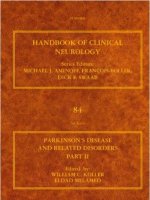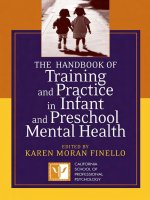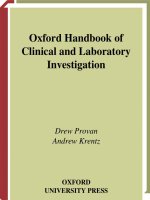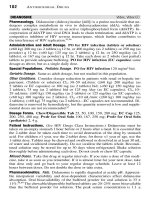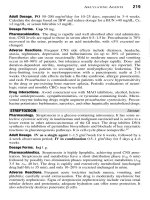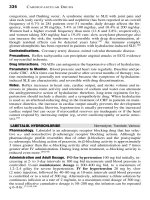Oxford Handbook of Clinical and Healthcare Research (1e 2016)
Bạn đang xem bản rút gọn của tài liệu. Xem và tải ngay bản đầy đủ của tài liệu tại đây (8.14 MB, 603 trang )
OXFORD MEDICAL PUBLICATIONS
Oxford Handbook of
Clinical and
Healthcare
Research
Published and forthcoming Oxford Handbooks
Oxford Handbook for the Foundation
Programme 4e
Oxford Handbook of Acute
Medicine 3e
Oxford Handbook of Anaesthesia 4e
Oxford Handbook of Applied Dental
Sciences
Oxford Handbook of Cardiology 2e
Oxford Handbook of Clinical and
Healthcare Research
Oxford Handbook of Clinical and
Laboratory Investigation 3e
Oxford Handbook of Clinical
Dentistry 6e
Oxford Handbook of Clinical
Diagnosis 3e
Oxford Handbook of Clinical
Examination and Practical Skills 2e
Oxford Handbook of Clinical
Haematology 4e
Oxford Handbook of Clinical
Immunology and Allergy 3e
Oxford Handbook of Clinical
Medicine – Mini Edition 9e
Oxford Handbook of Clinical
Medicine 9e
Oxford Handbook of Clinical Pathology
Oxford Handbook of Clinical
Pharmacy 2e
Oxford Handbook of Clinical
Rehabilitation 2e
Oxford Handbook of Clinical
Specialties 9e
Oxford Handbook of Clinical Surgery 4e
Oxford Handbook of Complementary
Medicine
Oxford Handbook of Critical Care 3e
Oxford Handbook of Dental
Patient Care
Oxford Handbook of Dialysis 4e
Oxford Handbook of Emergency
Medicine 4e
Oxford Handbook of Endocrinology
and Diabetes 3e
Oxford Handbook of ENT and Head
and Neck Surgery 2e
Oxford Handbook of Epidemiology for
Clinicians
Oxford Handbook of Expedition and
Wilderness Medicine 2e
Oxford Handbook of Forensic Medicine
Oxford Handbook of Gastroenterology &
Hepatology 2e
Oxford Handbook of General
Practice 4e
Oxford Handbook of Genetics
Oxford Handbook of Genitourinary
Medicine, HIV and AIDS 2e
Oxford Handbook of Geriatric
Medicine 2e
Oxford Handbook of Infectious
Diseases and Microbiology
Oxford Handbook of Key Clinical
Evidence
Oxford Handbook of Medical
Dermatology
Oxford Handbook of Medical Imaging
Oxford Handbook of Medical
Sciences 2e
Oxford Handbook of Medical Statistics
Oxford Handbook of Neonatology
Oxford Handbook of Nephrology and
Hypertension 2e
Oxford Handbook of Neurology 2e
Oxford Handbook of Nutrition and
Dietetics 2e
Oxford Handbook of Obstetrics and
Gynaecology 3e
Oxford Handbook of Occupational
Health 2e
Oxford Handbook of Oncology 3e
Oxford Handbook of
Ophthalmology 3e
Oxford Handbook of Oral and
Maxillofacial Surgery
Oxford Handbook of Orthopaedics
and Trauma
Oxford Handbook of Paediatrics 2e
Oxford Handbook of Pain Management
Oxford Handbook of Palliative Care 2e
Oxford Handbook of Practical Drug
Therapy 2e
Oxford Handbook of Pre-Hospital Care
Oxford Handbook of Psychiatry 3e
Oxford Handbook of Public Health
Practice 3e
Oxford Handbook of Reproductive
Medicine & Family Planning 2e
Oxford Handbook of Respiratory
Medicine 3e
Oxford Handbook of Rheumatology 3e
Oxford Handbook of Sport and Exercise
Medicine 2e
Handbook of Surgical Consent
Oxford Handbook of Tropical
Medicine 4e
Oxford Handbook of Urology 3e
Oxford Handbook of
Clinical and
Healthcare
Research
Editors
Associate Editors
Sumantra
(Shumone) Ray
Rajna Golubic
Senior Medical Advisor/Clinician
Scientist, Medical Research Council
(Human Nutrition Research) and
Chair of the UK Need for Nutrition
Education/Innovation Programme
(NNEdPro), Cambridge University
Hospitals/School of Clinical
Medicine; Fellow of Wolfson
College, University of Cambridge,
UK
Gates Scholar, Medical Research
Council and University of
Cambridge (Epidemiology Unit
and St. John’s College) and Trust
Doctor at the West Suffolk
Hospital, UK
Susan Fisher
Former Research Manager,
Medical Research Council (Human
Nutrition Research), Cambridge, UK
Sue Fitzpatrick
Editorial Assistance
Director at Redtree People and Sue
Fitzpatrick Training; Former Head
of Education and Training, The
Institute of Clinical Research, UK
Sarah Gibbings
Research Assistant/Coordinator,
Medical Research Council (Human
Nutrition Research), Cambridge, UK
1
1
Great Clarendon Street, Oxford, OX2 6DP,
United Kingdom
Oxford University Press is a department of the University of Oxford.
It furthers the University’s objective of excellence in research, scholarship,
and education by publishing worldwide. Oxford is a registered trade mark of
Oxford University Press in the UK and in certain other countries
© Oxford University Press 2016
The moral rights of the authorshave been asserted
First Edition published in 2016
Impression: 1
All rights reserved. No part of this publication may be reproduced, stored in
a retrieval system, or transmitted, in any form or by any means, without the
prior permission in writing of Oxford University Press, or as expressly permitted
by law, by licence or under terms agreed with the appropriate reprographics
rights organization. Enquiries concerning reproduction outside the scope of the
above should be sent to the Rights Department, Oxford University Press, at the
address above
You must not circulate this work in any other form
and you must impose this same condition on any acquirer
Published in the United States of America by Oxford University Press
198 Madison Avenue, New York, NY 10016, United States of America
British Library Cataloguing in Publication Data
Data available
Library of Congress Control Number: 2015941607
ISBN 978–0–19–960847–8
Printed and bound in China by
C&C Offset Printing Co., Ltd.
Oxford University Press makes no representation, express or implied, that the
drug dosages in this book are correct. Readers must therefore always check
the product information and clinical procedures with the most up-to-date
published product information and data sheets provided by the manufacturers
and the most recent codes of conduct and safety regulations. The authors and
the publishers do not accept responsibility or legal liability for any errors in the
text or for the misuse or misapplication of material in this work. Except where
otherwise stated, drug dosages and recommendations are for the non-pregnant
adult who is not breast-feeding
Links to third party websites are provided by Oxford in good faith and
for information only. Oxford disclaims any responsibility for the materials
contained in any third party website referenced in this work.
v
Foreword
Research is important: without it we cannot develop new knowledge on
why people get ill, what is the best treatment when they become ill, or how
best to prevent illness in the future. Research data is used to support clinical
decision-making, devising policy and making personal lifestyle decisions.
However, to provide a sound basis research must be robustly designed,
conducted and reported. In today’s world, research data is being put under
increasing scrutiny. It is becoming more common for research findings to
be challenged. Policy makers, health professionals and the public expect
research to be conducted transparently, including making research findings
widely available in an appropriate format.
This Oxford Handbook of Clinical and Healthcare Research provides a
practical guide for doctors, nurses, pharmacists, dieticians/nutritionists
and other health professionals as well as students/trainees involved in all
forms of clinical, translational, and public health research. It is timely with
the recent publication of the EU Clinical Trial Regulation that will be applied
in May 2016. This legislation will take the form of a regulation to ensure a
greater level of harmonization of the rules of conducting clinical trials in
Europe and a requirement for transparency. This handbook will provide
you with the tools you need to conduct robust research studies, to collect
valid and reproducible data and to do so in a manner that is open to scrutiny
whilst protecting the research participants from harm. The initial chapters
cover basic statistical concepts and study design, including discussion of how
to evaluate evidence. Later in the book there is a more in depth look at
clinical trials design, how to write a trial protocol and a description of the
drug development pathway.
The book will introduce you to Good Clinical Practice (GCP). Although
GCP is often seen as a bureaucratic burden, what it set outs to achieve is:
• To produce valid research data, and
• To protect the rights, dignity and well-being of participants.
Many specific aspects of GCP are picked up in the book, including study
monitoring, accountabilities of research staff and sponsors, IMP accountability and consent. GCP is not presented here as a recipe to follow by the
letter. Rather readers are encouraged to develop processes that deliver
what is needed for your study. It is through the development of a risk-based
approach to GCP that efforts can be focused on managing significant risks
posed to participants and to data validity. One size does not fit all.
Perhaps not surprisingly, conducting research in the UK (as well as more
widely) can involve a multitude of regulatory requirements. Many of these
are covered here, including the need for research ethics committee approval
and some of the processes used by the Health Research Authority, as well as
an overview of the Human Tissue Authority and Clinical Trial Authorisation
by the Medicines and Healthcare products Regulatory Authority. Beyond
the law, Research Governance defines specific responsibilities of individuals
and organizations, and requires appropriate lines of management and
communication to ensure high standards are maintained throughout the
vi
FOREWORD
research process. Again, the handbook provides an understanding of who
should be accountable for what, including how tasks should be delegated
to members of the research team. You can find out about safety reporting
requirements and what to do if the protocol is not followed.
The handbook also provides some details of how to conduct various
complex, study-related tasks. For example, how do you capture your
data? Accurate collection of data is central to delivering sound science. It
sounds simple enough, but if you are reliant on a team to collect and collate
data, how do you ensure that they are all doing things in the same way?
How can you be sure that the data collected by one person are equivalent those collected by another? How are you going to ensure that your
research data remain confidential? Equally, when conducting a blinded drug
trial, how do you ensure that all of your control group are indeed receiving
placebo/control treatment, in light of the fact that control and test drug
look identical? If your trial is taking place over a number of sites, how do
you ensure that each site has the correct blinded control/intervention
medication, and that it is stored correctly and used within its shelf life? How
do you make sure that all participants on the trial are randomized in the
agreed ratio, and are allocated to the correct blinded medication? Answers
to all these questions are provided.
You will also learn what you need to know about managing your study:
ensuring that you can complete on time and within budget. Guidance is
provided on how to use document control to ensure everyone is using the
correct version of protocols, consent forms or other documents. You are
also given information on archiving research records; an often forgotten
element that will require active management and possibly funding after your
study has ended.
At the end of the day, you would want to generate new, robust knowledge
about human health and disease, and to ensure that this knowledge is made
available to other experts, policy makers, prescribers, patients and the
general public so that they can consider it and use in their decision-making.
Publication is an important element of disseminating research findings and
guidance is given on how to go about publishing your findings to ensure
you maximise impact. We are now in an era where not disseminating your
research outputs, positive or negative, is simply not acceptable.
The handbook covers research fraud and misconduct. A culture that
supports quality research must consider the potential for fraud. High impact
publications can, and are, being challenged. This should not be considered
an insult, but rather an opportunity to demonstrate the quality of what you
do. With appropriate Quality Assurance in place, as described here, such
anxieties can be easily dispelled!
Finally, you will be expected to make your good quality research datasets
available to others, to input into meta-analyses, to undergo further scrutiny and re-analysis thereby maximizing their use and potentially helping
to inform policy development. Many funders and publishers are asking
that you consider sharing data through Open Access publication, DNA
sequence information and tissue samples to optimize their use. The ethical
imperative to share and maximize use should not, however, undermine
research participants’ right to confidentiality.
FOREWORD
Starting research for the first time can be daunting. A good researcher
will develop a multitude of skills and expertise over time. This Handbook
is a very good place to start. Using the start-up toolkit at the end of this
handbook, and you should find getting your study underway significantly
easier than you might first think.
Dr Rachel Smith
BSc, MSc, PhD
Head of Training and Communications
Regulatory Support Centre, UK Medical Research Council
Professor Chim C Lang
BMSc, MB ChB, MD, FRCP (Edin & Lond), FACC
Professor of Cardiology, Clinical Pharmacology and Medicine
Ninewells Hospital and Medical School, University of Dundee
Chair of Medical Academics (Scotland), British Medical Association
vii
ix
Preface
This book was commissioned to integrate guidance on how to conduct
both clinical as well as healthcare-related research. There are a multitude
of texts on clinical research alone and also stand-alone books on broader
healthcare-related research methods. In our handbook we have tried to
combine both of these skill-sets as seamlessly as possible, whilst pointing
out where the main differences lie. Since starting this handbook there have
been a number of significant changes to the clinical research landscape as
well as the drug development process, both in Europe and also globally.
In clinical trials, much more emphasis is now placed on patient outcomes
as well as demonstrating efficacy, whilst the ever widening scope of
healthcare-related research ranges from quantitative analyses of ‘big data’
across populations to in-depth qualitative and educational/behavioural
studies in individuals. The common denominator unifying both clinical and
wider healthcare-related research is the need to ensure high quality data
and the ability to readily translate findings for the benefit if patients and the
public. This joint mission has resulted in convergence of the disciplines that
underpin clinical and healthcare research.
The handbook is split broadly into three sections. Let us consider
each section in turn, through the story of five fictitious but fairly typical examples of students/trainees, each about to undertake research as
part of their degrees/training: Adam (Master’s Student in Nursing), Betty
(Pre-Registration Pharmacist), Jing (Medical Doctor in Academic Training),
Khaled (Physiotherapist in Research Training), and Vidya (Nutrition and
Dietetics Graduate on a PhD Programme). All five meet at a Research
Symposium and stumble upon this handbook as a recommended resource.
The first section deals with basic research methods. The chapters start
from the conceptual point of why we conduct research and the bedrock
of quantitative and qualitative know-how required as a first step towards
the investigation of any research question. This section also outlines
how evidence-based medicine and critical appraisal are utilized in an
applied research setting. Adam, Betty, Jing, Khaled, and Vidya all find this
section equally beneficial. Adam, who is undertaking a qualitative piece of
educational research draws mostly from the chapter written specifically in
this area. Vidya finds the basics of statistics and epidemiology most relevant
to strengthen concepts. Jing uses the critical appraisal section for weekly
journal clubs.
The second section deals with general research process. The chapters
deal with the regulatory environment, ethical, and safety requirements
when conducting a research project. The management of clinical research is
discussed and we take the reader through the life cycle of a research project
from concept to fruition and publication. All five characters in our story use
the material from this section as a toolkit to help navigate their individual
research journeys.
The third section also concentrates on research process but the exacting requirements of clinical trials in investigational products are detailed
x
PREFACE
and where there are significant differences in healthcare research these are
discussed. Khaled finds this section useful to delineate where the similarities
and differences lie in the methods and compliance measures required for
his trials of non-pharmaceutical treatments. Betty and Jing both find that this
section is particularly relevant to their aspirations of becoming a research
pharmacist, and clinical trialist, respectively. Vidya finds this section useful to
help decide that her research would be of a dietary rather than nutraceutical
nature. Adam uses this section for continuing professional development.
No matter whether the users of this handbook are students, trainees
or professionals, like our five fictitious characters, we are sure that this will
prove a useful resource both to the uninitiated as well as those looking to
read across horizontally between methodologies.
Throughout the book we provide examples wherever possible, key
references and signposting to other useful resources, including weblinks
which can be accessed for updates in this continuously moving field of
clinical and healthcare research.
We hope that this handbook will serve as a faithful companion to all those
undertaking clinical and healthcare research both across professions as well
as across the globe and we look forward to shaping future editions to the
evolving needs of a professionally diverse audience.
Acknowledgements
We would like to give heartfelt thanks to our many expert contributors for
their breadth and depth of knowledge which has culminated in this comprehensive handbook. We also express huge gratitude to the co-editors,
Rajna and Sue, and assistant editor, Sarah, who together with the Oxford
University Press team, including Michael and Fiona, have tried to keep us on
the straight and narrow.
It has been a very long journey from concept to completion but we
sincerely hope we have produced a useful pocket reference for any
healthcare professional who wishes to conduct meaningful research.
Finally we would like to thank Minha and Jim, our partners and family
(including Nikitah who entered the world during the compilation of this
handbook!) for their inordinate patience and support in the production
process!
xi
Contents
Contributors xiii
Symbols and abbreviations xv
1 Research: why and how ?
2 Navigating research methods: basic concepts
in biostatistics and epidemiology
3 Navigating research methods: quantitative
and clinical/epidemiological methods
4 Navigating research methods: qualitative methods
5 Navigating research methods: evidence-based
medicine (EBM)
6 Navigating research methods: critical appraisal
7 Navigating research methods: clinical audit
8 Setting the scene and ICH GCP in clinical
and healthcare research
9 Informed consent in a research setting
10 Ethics of clinical and healthcare research:
general considerations, Mental Capacity Act,
Human Tissue Act
11 Role and responsibilities: investigator and
research team
12 Role and responsibilities of the sponsor
13 Monitoring
14 Clinical trial design
15 Clinical trial protocols: study protocol
16 Data capture tools: case report form (CRF)
1
19
39
57
75
79
91
101
125
143
169
185
231
265
297
317
xii
CONTENTS
17 Clinical trial supplies: investigational
medicinal products (IMPs)
18 IMP accountability
19 Safety reporting
20 Data management
21 Research project management
22 Essential documents
23 Archiving
24 Audits and inspections
25 Fraud and misconduct
26 Authorship
27 Publication process
28 Start-up toolkit: from funding an idea, through
implementation, to achieving an impact
Index 571
339
367
391
407
419
433
453
469
497
515
525
543
xiii
Contributors
Pauline Allen
Chris Graf
eCRF/CRF Design Manager,
Syna Qua non Ltd, Diss Business
Park, UK
Associate Editorial Director
Wiley-Blackwell UK
Suzanna Almoosawi
eCRF/CRF Design Manager,
Syna Qua non Ltd, Diss Business
Park, UK
Research Associate, Newcastle
University,
Human Nutrition, Research
Centre and Institute of Health &
Society, Medical School, Newcastle
University, UK
Sarah Casey
Health, Safety and Quality
Manager, Medical Research
Council,
Human Nutrition Research,
Elsie Widdowson Laboratory,
Cambridge, UK
Darren Cole
Manager of Data Operations
Medical Research Council,
Human Nutrition Research,
Elsie Widdowson Laboratory,
Cambridge, UK
Nicky Dodsworth
VP, Quality Assurance, Risk &
Research, Premier Research,
Wokingham, UK
Nina Downes
Director, Diamond Clinical, High
Wycombe, UK
Joan Gandy
Lead Scientific Advisor
UK Need for Nutrition
Education/Innovation Programme
(NNEdPro), Cambridge, UK
Helen Glenny
Clinical Research Consultant,
Welwyn Garden City, UK
Karen Grover
Lyn Haynes
Senior Lecturer
Canterbury Christchurch
University, Canterbury, UK
Janice Hedgecock
Director, Greatspur Clinical
Development, Norwich, UK
Babara Hepworth Jones
Head, Process and Training
Country Clinical Operations UK,
Roache Product Ltd, Welwyn
Garden City, UK
Helen Hill
Research Fellow, University
of Liverpool, Department of
Women’s and Children’s Health,
Institute of Translational Medicine,
Liverpool, UK
Liz Hooper
Archivist and Records Management
Consultant, Phlex Global,
Amersham, UK
Sheri Hubby
Senior Director, US Quality
Assurance, Risk & Compliance,
Premier Research, Fort Myers,
Florida, USA
Golam Kabir
Researcher, University of Dundee
Medical School, Dundee, UK
xiv
CONTRIBUTORS
Priya Kalia
Minha Rajput Ray
Research Associate,
Biomaterials, Biomimetics,
Biophotonics Division, Dental
Institute, King’s College
London, UK
Lead Medical Advisor,
UK Need for Nutrition
Education/Innovation Programme
(NNEdPro), Cambridge, UK
Eric Klaver
Specialty Registrar/Clinical
Research Fellow, Division of
Cardiovascular and Diabetes
Medicine, Ninewells Hospital and
Medical School
Dundee, UK
Director, FourPlus Clinical,
Amsterdam, The Netherlands
Chim Lang
Professor of Cardiology,
Division of Cardiovascular and
Diabetes Medicine, Ninewells
Hospital and Medical School
Dundee, UK
Alan Robertson
David Talbot
Director, Diamond Clinical, High
Wycombe, UK
Celia Laur
Ben Thompson
Researcher in Applied Health
Sciences,
University of Waterloo,
Onatario, Canada
Postgraduate, British College of
Osteopathic Medicine, London, UK
Sue Miles
Head of Clinical Trials,
Brecon Pharmaceuticals Ltd,
Hay-on-Wye, UK
Polly Page
Group leader: Nutrition, Surveys
and Studies Medical Research
Council, Human Nutrition
Research, Elsie Widdowson
Laboratory, Cambridge, UK
Richard Parker
Statistician, University of
Edinburgh, Edinburgh, UK
Ruzan Udumyan
Epidemiologist at Clinical
Epidemiology and Biostatistics,
Örebro University Hospital;
and School of Health and
Medical Sciences, Örebro
University, Sweden
Cheryl Whitehead
Independent Pharmaceutical
Professional, High Wycombe, UK
Lou Whelan
Managing Editor
The Journal Office,
UK
xv
Symbols and abbreviations
ABPI
Association of the British Pharmaceutical Industry
ACE
angiotensin converting enzyme
ACLS
Aerobics Center Longitudinal Study
ADME
absorption distribution metabolism and excretion
ADR
adverse drug reaction
AEadverse event
AIP
application integrity policy
ALCOA
attribute, legible, contemporaneous, original, accurate
AMI
acute myocardial infarction
AMRC
Association of Medical Research Charities
ANOVA
analysis of variance
API
active pharmaceutical ingredient
ARattributable risk
AR
adverse reaction
ARIC
Atherosclerosis Risk in Communities Study
ARSAC
Administration of Radioactive Substances Advisory
Committee
AUC-ROC
area under the curve receiver operating characteristic
AVaudio visual
BLA
biologics licence applications
BMA
British Medical Association
BMI
body mass index
BMJ
British Medical Journal
C of A
certificate of analysis
CA
competent authority
CAPA
corrective and preventative action
CAT
computerized tomography scan
CDcompact disk
CDF
career development fellowships
CDP
clinical development plan
CFR
Code of Federal Registers
CGSDI
clinical governance support and development indicator
CHAIN
Contact Help Advice and Information Network
CHARM
Candesartan in Heart Failure: Assessment of
Reduction in Mortality and Morbidity
CHMP
Committee for Human Medicinal Products
CHRE
Council for Healthcare Regulatory Excellence
xvi
SYMBOLS AND ABBREVIATIONS
CI
chief investigator
CI
confidence interval
CI
cumulative incidence
CINAHL
Cumulative Index to Nursing and Allied Health Literature
Cmax
maximum concentration of the treatment in the body
CONSORT
Consolidated Standards of Reporting Trials
COPE
Committee on Publication Ethics
CPMP
Committee for Proprietary Medicinal Products
CRA
clinical research associate
CRC
clinical research coordinator
CRF
case record form
CRO
Contract Research Organization
CSR
clinical study report
CTclinical trial
CTA
clinical trial administrator
CTA
Clinical Trial Agreement
CTA
Clinical Trial Authorization
CTIMP
clinical trials in investigational medicinal products
CTMS
clinical trial management systems
DARE
Database of Abstracts of Reviews of Effects
DCF
data clarification form
DI
designated individual
DIA
Drug Information Association
DM
doctorate in medicine (superspeciality)
DNAdeoxyribonucleic acid
DPA
Data Protection Act
DQLI
Dermatology Quality Life Index
DrPH
doctorate in public health
DSUR
development safety update report
E6
ICH efficacy guideline number six
EBG
evidence-based guideline
EBID
evidence-based individual decision-making
EMB
evidence-based medicine
EC
Ethics Committee
ECG
electro cardio graph
eCRF
electronic case record form
EDC
electronic data capture
eDCT
electronic data capture tools
EEA
European Economic Area
SYMBOLS AND ABBREVIATIONS
EHR
EIC
EMA
EMBASE
EMWA
EPAR
EPIC
electronic health records
editor in chief
European Medicines Agency
Excerpta Medica dataBASE
European Medical Writers Association
European Public Assessment Report
European Prospective Investigation into Cancer
and Nutrition
EPSRC
Engineering and Physical Sciences Research Council
ESC
European Society of Cardiology
eTMF
electronic trial master files
EUEuropean Union
EudraCT
European Union Drug Regulating Authorities Clinical
Trials Database
EVDB
EudraVigilance Database
FD
financial disclosure
FDA
Food and Drug Administration
FOI
freedom of information
FTP
free transfer protocol
GCP
good clinical practice
GCP RMA
Good Clinical Practice Records Managers Association
GLP
good laboratory practice
GMC
General Medical Council
GMP
good manufacturing practice
GP
general practitioner
GSK
Glaxo Smith Klein
GxP
good (clinical, laboratory, manufacturing pharma
covigilance) practice
HF
heart failure
HF-ACTION
heart failure: a controlled trial investigating outcomes
of exercise training
HIPAA
Health Insurance Portability and Accountancy Act
HIV
human immunodeficiency virus
HOD
head of department
HSC
health and social care
HT Act
Human Tissue Act
HTA
Human Tissue Authority
HFEA
Human Fertilisation and Embryology Authority
IB
investigator brochure
IC
informed consent
xvii
xviii
SYMBOLS AND ABBREVIATIONS
ICF
ICH GCP
informed consent forms
International Conference on Harmonisation of Good
Clinical Practice
ICMJE
International Committee of Medical Journal Editors
IDidentification
IDMC
Independent Data Monitoring Committee
IEC
Independent Ethics Committee
IMP
investigational medicinal products
IMPD
Investigational Medicinal Product Dossier
IMRAD
introduction, methods, results and discussion
INTERHEART
a global case-control study of risk factors for acute
myocardial infarction
IOM3
Institute of Materials, Mining and Metallurgy
IOP
intraocular pressure
IP
investigational product
IRincidence rate
IRAS
Integrated Research Application System
IRB
institutional review board
ISF
investigator site file
ISI
Inter Service Intelligence
ISO
International Organization for Standardization
IT
information technology
IVintravenous
IVRS
interactive voice recognition system
IWRS
interactive web response system
JAMA
Journal of American Medical Association
JUPITER
Justification for the Use of Statins in Primary Prevention:
an Intervention Trial Evaluating Rosuvastatin
LHlicence holder
LRlikelihood ratio
MAA
marketing authorization approval
MAH
marketing authorization holder
MA (IMP)
MHRA Register of Holders of Manufacturers
Authorisations for Investigational Medicinal Products
MCRN
Medicines for Children Research Network
MD
doctor of medicine (post-graduation)
ME
myalgic encephalopathy
MEDLINE
Medical Literature Analysis and Retrieval
System Online
MCT
Mental Capacity Act
MHRA
Medicines and Healthcare Products Regulatory Agency
SYMBOLS AND ABBREVIATIONS
MI
myocardial infarction
MODEPHARMA medication services for clinical trials
MPhil
master of philosophy
MRC
Medical Research Council
MRes
master of research
MRI
magnetic resonance imaging
MSmember state
MSc
master of science
MTD
maximum tolerated dose
NCR
no carbon required
NDA
new drug application
NeLH
National Electronic Library for Health
NHANES
National Health and Nutrition Examination Survey
NHS
National Health Service
NICE
National Institute for Health and Care Excellence
NIH
National Institute of Health
NIHR
National Institute for Health Research
NIMP
non investigational medicinal product
NMAPnetwork mapper
NNT
number needed to treat
NOAEL
no observable adverse effect level
NPL
National Physics Laboratory
NRES
National Research Ethics Service
NVivo
NVivo qualitative data analysis software
OMNI
organizing medical networked information
ORIodds ratio
ORI
Office of Research Integrity
Pprobability
PASS
post-authorization safety studies
PDpharmacodynamics
PD
persons designated
portable document format
PGxpharmacogenetics
PhD
doctor of philosophy
PHS
Public Health Service
PI
principal investigator
PIS
patient information sheet
PKpharmacokinetic
PLoS
Public Library of Science
PM
project manager
xix
xx
SYMBOLS AND ABBREVIATIONS
PREDIMED
study assessing the efficacy of the Mediterranean
diet in the prevention of cardiovascular diseases
PRISMA
preferred reporting items for systematic reviews
and meta-analyses
PSUR
periodic safety update report
PVpredicted value
QA
quality assurance
QALY
quality adjusted life years
QC
quality control
QoL
quality of life
QPqualified person
R&D
research and development
RAE
research assessment exercise
RCT
randomized controlled trial
REregional editor
REC
Research Ethics Committee
REF
Research Excellence Framework
RGF
Research Governance Framework
RNAribonucleic acid
RRrelative risk
RSI
reference safety information
RSM
Royal Society of Medicine
SaaS
Software as a Service
SAE
serious adverse events
SBA
summary basis of approval
SD
standard deviation
SDV
source data verification
SEstandard error
SEsubject editor
SF 36
short form health survey
SFDA
State Food and Drug Administration (China)
SHSCW
Specialist Health Services Commission for Wales
SI
statutory instrument
SIGN
Scottish Intercollegiate Guidelines Network
SMART
specific, measurable, achievable, realistic
and time bound
SMO
Site Management Organization
SmPC
summary of medicinal product characteristics
SOP
standard operating procedures
SPA
special protocol assessments
SPOKE
structure processes outputs knowledge exchange
SYMBOLS AND ABBREVIATIONS
SPSS
SQUIRE
STROB
SUSAR
TCES
TIMI
TLF
TMF
TSB
UKRIO
UKSB
USB
USM
VPN
WHI
WHO
WI
WISDOM
WISE
WMA
statistical package for the social sciences
Standards for Quality Improvement Reporting
Excellence
STrengthening the Reporting of OBservational studies
in epidemiology
suspected unexpected serious adverse reactions
Tissue and Cell Engineering Society
Thrombolysis in Myocardial Infarction
tables, listings and figures
trial master file
Technology Strategy Board
United Kingdom Research Integrity Office
United Kingdom Society for Biomaterials
universal serial bus
urgent safety measures
virtual private networks
Women’s Health Initiative
World Health Organization
work instructions
WISDOM Centre for Clinical Governance
Women in Science, Engineering and Construction
World Medical Association
xxi
Chapter 1
Research: why and how?
The importance of research 2
The scientific method: how do we know something is true
or really works? 6
Different types of research 10
Hierarchy of evidence 14
Final remarks 16
Further reading 17
1
2
Chapter 1
Research: why and how?
The importance of research
What is research?
Research is broadly defined as a systematic investigation with the aim of
advancing existing knowledge. It is a process of rigorous reasoning which
is based on theories, methods, and findings. It relies on the application of
the scientific method and uses inquiries, observations, and experiments to
answer questions about the causes of different phenomena. Importantly,
scientific research does not give absolute answers but provides probable
answers based on the evidence. The main purpose of research is to inform
action.
Medical research: overview of recent history
Over the last two centuries medical research has resulted in significant drug
discoveries that have improved people’s lives, such as penicillin and other
antibiotics, vaccines for various infectious diseases, aspirin, beta-blockers,
insulin, etc. Furthermore, the explosion of medical technology has led to
the introduction of new diagnostic procedures such as X-rays, electrocardiography, defibrillation, medical ultrasonography, magnetic resonance, etc.,
which substantially improved detection of diseases. The modern era of
surgery has made a great impact on human health after the introduction of
organ transplantation, open-heart surgery, and joint replacement.
Before the 1950s conclusions about human diseases were made based on
the study of anatomy, physiology, and pathology, using case studies or case
series as the main method. Statistical techniques were not used in medicine
prior to then. Statisticians who made a marked contribution to the application of statistics in medicine include:
•Ronald Fisher—father of modern statistics
•Austin Bradford Hill—wrote a series of articles published in the Lancet
about the use of statistics in medical research, and a commentary in
the British Medical Journal in which he proposed statistics as part of the
medical curriculum.
The role and importance of research in everyday
clinical practice
In their everyday work, healthcare professionals rely on common sense a
great deal. However, there are various explanations for observed clinical
phenomena and they do not necessarily take into account external factors.
There are numerous guidelines that clinicians have to follow in order to
deliver the best possible care for the patient. One example is the National
Institute for Health and Care Excellence (NICE) guidance which contains
recommendations on the most effective way to diagnose, treat, and prevent diseases. The three main areas in which NICE publishes guidelines are
health technologies, clinical practice, and health promotion and ill-health
avoidance. This guidance is developed according to the best available evidence from the medical literature which is based on the findings of clinical
and healthcare research and evaluation of efficacy and cost-effectiveness of
different circumstances.


